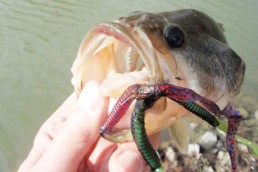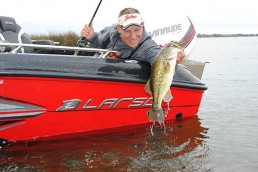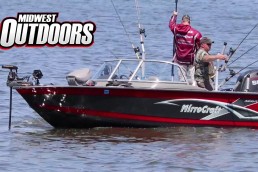Identifying the Right Signs Leads to Fishing Success
SHARE THIS POST
Spring is in the air, the weather is fine and many of us are looking forward to a summer vacation and doing some fishing.
The big question is, where are the fish?
The answer is, they are either deep or shallow. Sounds complicated, but it is not that complicated at all.
Most predatory fish—bass, bluegills and walleyes—follow a regular routine. During the morning and evening hours they invade the shallows to feed on small baitfish, frogs, crayfish and other crustaceans. During the bulk of the daylight hours they inhabit deeper water where they digest their food. While moving from one locale to the other, they follow paths that resemble underwater “road maps.” From the depths, they follow creek channels, stump beds, ledges and drop-offs, long, rocky underwater points and so forth until they reach their feeding grounds in the shallows.
They feed in the morning and evening because the sun is at its lowest position on the horizon, the sky is dark and the plankton and other small organisms are on the move. The baitfish dine on the plankton and the larger fish follow the food, invading the shallows and gorging upon the smaller fish. When light increases, the plankton movement stalls as baitfish retreat to cover and predators follow their same routes back to the depths.
One of the most visible signs of activity is a series of “swirls” in the water that indicate the presence of feeding fish. Once while wading a river I actually saw weeds moving along the edge of a stream. A well-placed cast resulted in a healthy strike from a nice smallmouth bass that had been in the weeds gorging on minnows.
There is nothing more exciting than seeing a largemouth bass feeding in the shallows, and casting a Jitterbug or a Hula Popper or other topwater lure toward it and having it smashed by the big-mouthed fish.
Are you enjoying this post?
You can be among the first to get the latest info on where to go, what to use and how to use it!
Another indicator of a fish’s presence is one minnow or more seen skipping across the surface of the water. They are not jumping for joy, but undoubtedly are trying to escape the maw of a hungry fish. Once I waded the Auglaize River during the early morning hours, and I saw this happen near the shore. One cast brought a vicious strike from a smallmouth, about 12 inches long. I knew it was feeding because as it fought in the water, it disgorged a partially digested minnow. The same scenario repeated itself several times that morning and usually resulted in numerous strikes.
Mother Nature can be an ally rather than an adversary if we only take the time to decipher what she is telling us: A heron standing in the water suddenly takes a step or two forward or a kingfisher flying down the river and alights itself on a log in the river are indications a school of minnows are present. And if food is there, so will larger fish.
In another scenario, let’s say you have the day off. You drive to your favorite fishing hole and find that due to recent rains the water is high and somewhat murky. The solution? Fish shallow—the minnows will be in the shallow water feeding or hiding to escape from being eaten. The bass and bluegills instinctively know this and will be there to eat them.
The water is low? The solution is to fish as deep and as close to “cover” as you can, including boulders, downed trees, docks, bridge pilings, submerged weed beds, sunken Christmas trees and so forth. Predators, such as bass and crappies, are “object-oriented,” meaning that when not actively feeding, they hold close to any object in the water that offers sanctuary, and from which they can dart out and grab an easy meal swimming by.
Finally, there are a couple of differences in the two major species of bass: Largemouths are more likely to be found in slower-moving, warmer waters, which is why they are so ideally suited for farm ponds while smallmouths are not. Smallmouths live and die by the current, meaning that they prefer cooler, flowing waters such as rivers and deep impoundments. About 98 percent of the time they will be found facing into the current and will be situated over rocky or sandy-bottom areas or lying near scattered boulders. They face into the current because that is the direction from which their food will arrive. Therefore, about 98 percent of anglers’ casts should be made upstream and the lure or live bait should be retrieved toward the angler. Do not be surprised if the fish follows and smashes the bait about 2 feet in front of you—this type of fishing may not be for the faint of heart.
MWO
SHARE THIS POST
Did you enjoy this post?
You can be among the first to get the latest info on where to go, what to use and how to use it!
John Bennett
John Bennett is a retired history teacher, historical re-enactor, father and grandfather. As a four-season outdoorsman, his passion is waterfowl hunting and fishing for smallmouth bass. He lives in Ohio and spends quite a bit of time in his primitive log cabin, which he built.



